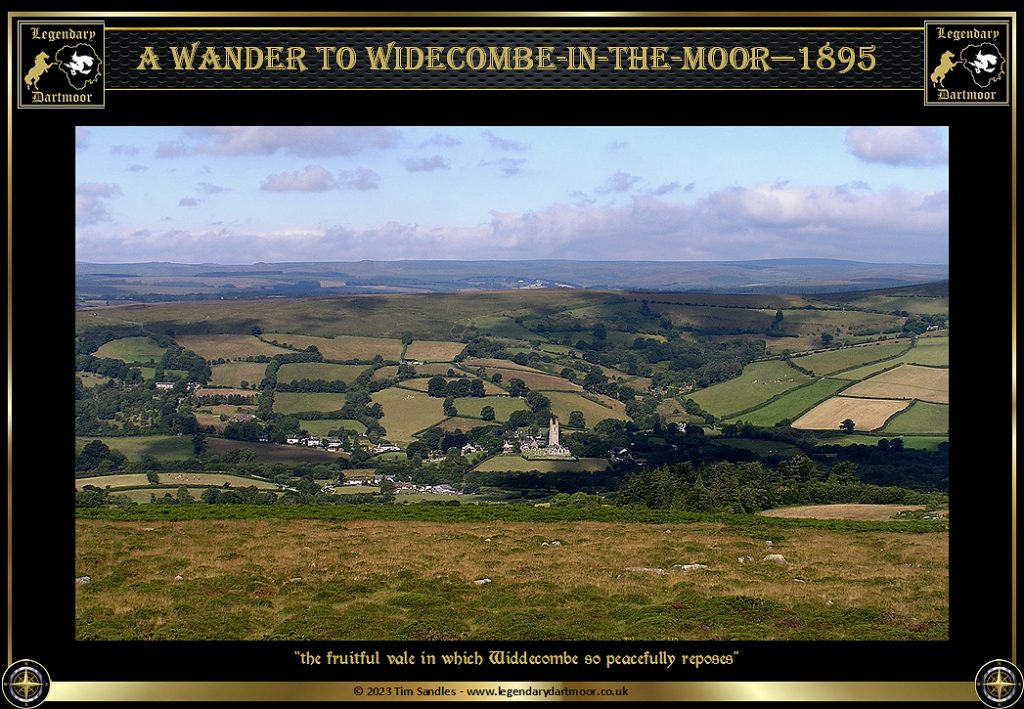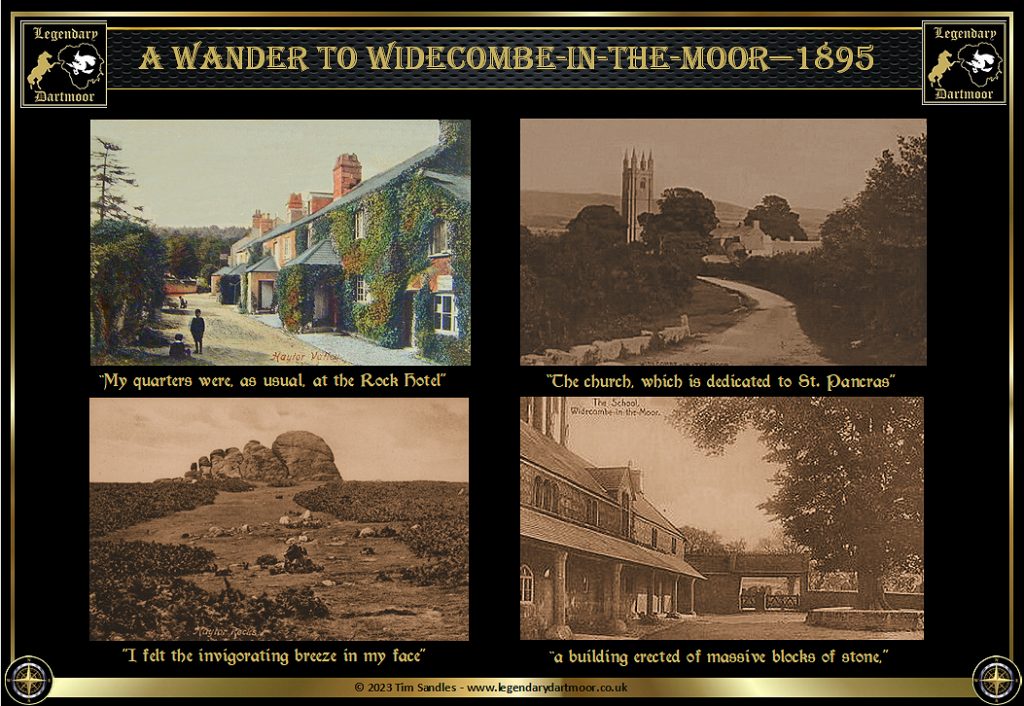
In the late 1890s the editor of the Torquay Times wrote several articles under the title of “Some Devonshire Villages. In the July of 1895 he published article number seven when he visited Widecombe-in-the-Moor and in which he described his excursion…
“My quarters were, as usual, at the Rock Hotel, in Haytor Vale, a neighbourhood becoming quite aristocratic, since two Torquay solicitors have cottages there, and the Vicar of All Saints’, Babbacombe, has just built himself a very modest, unpretentious moorland retreat. I reached my quarters on the afternoon of Friday, and after a walk to Ilsington and back, partook of a generous tea, and later on a frugal supper, consisting of a biscuit and a glass of milk, with just a tablespoon of whisky in it to help digestion. Shortly after nine o’clock – I always go to bed early on the moors – I retired to rest and slept soundly for ten hours. On rising in the morning I opened my lattice window, and was refreshed with the brisk moorland air, which, though lively, was neither cold nor aggressive.
Fortified with a breakfast, the extent of which somewhat astonished me, I set out for Widecombe, and as I mounted the rising ground in front of Haytor Rock, and as I reflected that I was between 1000 and 1500 feet above the level of the sea, I felt the invigorating breeze in my face, and was conscious of my lungs being inflated with pure rarefied air, I moved forward with a buoyant step, and with a feeling that on this moorland hygeia I was taking in some measure of health in every inspiration. I eschewed the road which stretched far away like a narrow ribbon, and kept to the soft, elastic, velvet-like turf, pulling up ever and anon to enjoy the delightful pastural landscape which, in Torquay direction, found its limit only on the seashore.
I trudged along finding solace in my constant companion that favours me with an incense that is ever fragrant and was conscious of having walked several miles without having met a single person, nor encountered any incident which might help to relieve this article from dull monotony. Suddenly I came upon a tweed cloth cap such as tourists affect, and which usually costs about eighteen pence. I looked around but no owner of the cap was in view. I turned it over and over with my walking stick. In the same manner I examined the lining, but the maker, if there was a mystery there it was not going to be found. I gave up in despair, but still wondered why that cap was there, why the owner had never missed it, or whether he had been killed and his body buried in a cairn upon the moor. I left the cap where I had discovered it and the mystery will remain.
A few hundred yards further on my attention was arrested by something more romantic and mysterious. A fond lover had sought to inscribe the name of his fair Innamorato in enduring granite. Truly love is blind, and “lovers cannot see the pretty follies that themselves commit.” The letters of full size had been cut in the turf, the indentation being filled with small bits of granite, but a large granite boulder cropping up through the turf, had arrested the young lover’s aspiration, and cut short the name which he fain would have inscribed, so that it came out thus – FLO JAM. No doubt the succulent compound was sufficiently descriptive of the object of his affections.
But I must hasten on, for Widecombe is still two or three miles off. I shortly reach the crest of the hill, which forms one side of the fruitful vale in which Widdecombe so peacefully reposes. Around the grand old church about half a dozen houses cluster and scattered through the valley I can count but a score more. I wonder whence came the population of 744, with which the parish is credited in the census of 1891, until reference to a guide informs me that the parish includes the hamlets of Cator, Ponsworthy, Poundsgate, Pinchaford, Fernhill, Dunstone, Blackslade, and Lower Tor. Looking across upon the opposite hill, I noticed the rich verdant colour of the hedges which intersect the irregular shaped fields, and the picture presented reminded me of the toy puzzles which a generation ago delighted the hearts and taxed the ingenuity of the children of that period. Near the church there is a building erected of massive blocks of stone, which in its style of architecture recalled recollections of Normandy. This building, I was informed, was formerly an alms house, but the upper floor is now devoted to the purposes of the village school, and as to the ground floor a portion only is now used, and that is the residence of the sexton. It forms one side of an open space, in the centre of which is a gigantic elm tree, and a modern Lych gate marks the way into the church yard. The church, which is dedicated to St. Pancras, a young martyr of the Diocletian persecution 304 A.D., is a cruciform building in the perpendicular style of architecture. At the western end is a very fine embattled tower, surmounted by four pinnacles, so lofty in height, and so massive in structure that it appears to dwarf the nave and chancel. The tower, which was built 100 years later than the church is 824 feet above sea level, 112 steps lead to its summit, and the height to the top of the pinnacles is 130 feet.” The article then went on to detail the church and the frightful storm of 1631 more of which can be found on another Legendary Dartmoor page – HERE.
As I left the church, I met with that sexton, who was cutting the grass of God’s acre, and with whom I had a chat. As I talked with him he related a conversation he had once held with a lady visitor to the church. “First along,” said he, “they called I the beadle; then there come a new parsun, and he called I the sextun, but this ‘ere young vicar be a bit high church, an’ he calls I the virgin.” Soon after leaving the church, I was mounting up the hill leading to the moor, with an appetite keenly sharpened by the invigo rating air, and, on returning to the Rock Hotel, I found a good dinner, which included the well-known Devonshire dish, whortleberry pie and clotted cream, awaiting me. I dined, was happy and contented, and well pleased with my walk to Widecombe-in-the- Moor.”
It would be interesting to know where the “FLO JAM” inscription found by the author was located and if it still exists?
 Legendary Dartmoor The many aspects past and present of Dartmoor
Legendary Dartmoor The many aspects past and present of Dartmoor


